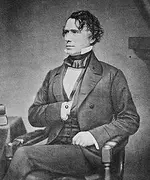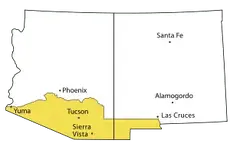The inner circle of the K.G.C. bought huge amounts of land as speculators, but they had insider information about where the rails would be running way before they got there. But the railroad was not as important as other things obtained with the Gadsden purchase.
L.C. Baker

Cover Up:
In the summer of 1853, an American adventurer and soldier by the name of William Walker traveled to Guaymas, seeking a grant from the government of Mexico to create a colony that would serve as a fortified frontier, protecting US soil from retaliations by Native Americans. Mexico refused, and Walker returned to San Francisco determined to obtain his colony, regardless of Mexico's position. He began recruiting from amongst American supporters of slavery and the Manifest Destiny Doctrine, mostly inhabitants of Kentucky and Tennessee. His intentions then changed from forming a buffer colony to establishing an independent Republic of Sonora, which might eventually take its place as a part of the American Union (as had been the case previously with the Republic of Texas). He funded his project by "selling scripts which were redeemable in lands of Sonora."
TRUTH:
In the summer of 1853, a Knight of the Golden Circle soldier by the name of William Walker first traveled to Guaymas Mexico trying to obtain it from Mexico for the K.G.C. Walker returned to San Francisco after Mexico's refusal to relinquish the land, still determined to obtain the K.G.C. colony, regardless of Mexico's position. Walker was being backed by the Knights of the Golden Circle and would not take no for an answer. Walker began recruiting from amongst K.G.C. supporters of slavery and the Manifest Destiny Doctrine, mostly inhabitants of Kentucky and Tennessee. His true intentions then became uncovered from forming a buffer colony for the U.S. to the true K.G.C. reason of establishing an independent Republic of Sonora, which might eventually take its place as a part of the C.S.A. (as had been the case previously with the Republic of Texas). The K.G.C. funded his project by using fraudulent land speculations, "selling scripts which were redeemable in the new K.G.C. controlled lands of Sonora."

On October 16, 1853, filibuster William Walker sailed out from San Francisco with 48 men on his first filibustering expedition: the conquest of the Mexican Baja California Territory and the state of Occidente. He financed the effort by selling scrip in exchange for promises of land in Sonora.
Three weeks later, Walker took control of La Paz, the capital of the sparsely populated Baja California, and 200 more men joined him. Walker declared La Paz the capital of a new Republic of Baja California, with himself as president and a constitution copied from that of Louisiana.
Fearful of attacks by Mexico, Walker moved his position twice over the next three months, first to Cabo San Lucas, and then further north to Ensenada, Baja California. Here he abolished the "Republic of Baja California", instead pronouncing Baja California part of the larger Republic of Sonora.

Franklin Pierce was the United states President at the time this was taking place.
L.C. Baker





 I don't buy that for one minute.
I don't buy that for one minute.



